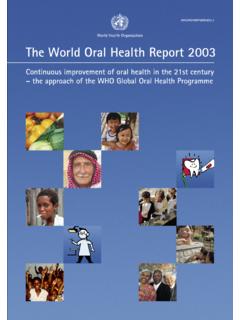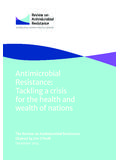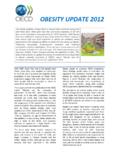Transcription of he WORLD HEALTH REPORT 2000 - who.int
1 Ealth ystems: mproving erformance heWORLDHEALTHREPORT2000 WORLD HEALTH ORGANIZATIONiiThe WORLD HEALTH REPORT 2000 WHO Library Cataloguing in Publication DataThe WORLD HEALTH REPORT 2000 : HEALTH systems : improving WORLD HEALTH 2. HEALTH systems plans 3. Delivery of HEALTH care4. HEALTH services administration 5. Financing, HEALTH 6. HEALTH servicesaccessibility 7. Social justice 8. HEALTH care evaluation mechanismsI. Title: HEALTH systems : improving performanceISBN 92 4 156198 X (NLM Classification: WA )ISSN 1020-3311 The WORLD HEALTH Organization welcomes requests for permission to reproduce or translate its publica-tions, in part or in full. Applications and enquiries should be addressed to the Office of Publications, WorldHealth Organization, 1211 Geneva 27, Switzerland, which will be glad to provide the latest information onany changes made to the text, plans for new editions, and reprints and translations already available.
2 WORLD HEALTH Organization 2000 All rights designations employed and the presentation of the material in this publication, including tables andmaps, do not imply the expression of any opinion whatsoever on the part of the Secretariat of the WorldHealth Organization concerning the legal status of any country, territory, city or area or of its authorities,or concerning the delimitation of its frontiers or boundaries. Dotted lines on maps represent approximateborder lines for which there may not yet be full mention of specific companies or of certain manufacturers products does not imply that they areendorsed or recommended by the WORLD HEALTH Organization in preference to others of a similar naturethat are not mentioned. Errors and omissions excepted, the names of proprietary products are distin-guished by initial capital concerning this publication can be obtained from: WORLD HEALTH ReportWorld HEALTH Organization1211 Geneva 27, SwitzerlandFax: (41-22) 791 4870 Email: of this publication can be ordered from: principal writers of this REPORT were Philip Musgrove, Andrew Creese,Alex Preker, Christian Baeza, Anders Anell and Thomson Prentice, with con-tributions from Andrew Cassels, Debra Lipson, Dyna Arhin Tenkorang andMark Wheeler.
3 The REPORT was directed by a steering committee formed byJulio Frenk (chair), Susan Holck, Christopher Murray, Orvill Adams, AndrewCreese, Dean Jamison, Kei Kawabata, Philip Musgrove and Thomson input was received from an internal advisory group and a regionalreference group, the members of which are listed in the help and advice were gratefully received from regional directors,executive directors at WHO headquarters and senior policy advisers to conceptual framework that underpins the REPORT was formu-lated by Christopher Murray and Julio Frenk. The development of new ana-lytical methods and summary indicators, new international data collectionefforts and extensive empirical analysis that form the basis for the reportwas undertaken by over 50 individuals, most of them from the WHO GlobalProgramme on Evidence for HEALTH Policy, organized in eleven workinggroups.
4 These groups covered basic demography, cause of death, burden ofThe cover shows a photograph of a sculpture entitled Ascending Horizon by Rafael Barrios, in Caracas,Venezuela. The photograph by Mireille Vautier is reproduced with the kind permission of ANA Agencephotographique de presse, Paris, by Marilyn Langfeld. Layout by WHO GraphicsPrinted in France2000/12934 Sadag 30 000disease, disability-adjusted life expectancy, HEALTH inequalities, responsive-ness, fairness of financial contribution, HEALTH system preferences, nationalhealth accounts and profiles, performance analysis and basic economic of each working group are listed in the Acknowledgements. Mana-gerial and technical leadership for the working groups was provided by JulioFrenk, Christopher Murray, Kei Kawabata, Alan Lopez and David Evans. A se-ries of technical reports from each of the working groups provides detailson the methods, data and results, beyond the explanations included in theStatistical general approach to this REPORT was discussed at an interna-tional consultative meeting on HEALTH systems, and the measurement ofresponsiveness was facilitated by a meeting of key informants.
5 Both meet-ings were held in Geneva in December 1999 and the participants are listedin the REPORT was edited by Angela Haden, assisted by BarbaraCampanini. Administrative and technical support for the WORLD HEALTH Re-port team were provided by Shelagh Probst, Michel Beusenberg, AmelChaouachi and Chrissie Chitsulo. The index was prepared by Liza FROM THE DIRECTOR-GENERALVIIOVERVIEWXIHow HEALTH systems have evolvedxiiiThe potential to improvexivProviding better servicesxvFinding a better balancexviProtecting the poorxviiiCHAPTER 1 WHY DO HEALTH SYSTEMS MATTER?1 The changing landscape3 What is a HEALTH system?5 What do HEALTH systems do?7 Why HEALTH systems matter8 How modern HEALTH systems evolved11 Three generations of HEALTH system reform13 Focusing on performance17 CHAPTER 2 HOW WELL DO HEALTH SYSTEMS PERFORM?21 Attainment and performance23 Goals and functions23 Goodness and fairness: both level and distribution matter26 Measuring goal achievement27 Overall attainment: goodness and fairness combined40 Performance: getting results from resources40 Improving performance: four key functions44 CHAPTER 3 HEALTH SERVICES: WELL CHOSEN, WELL ORGANIZED?
6 47 Organizational failings49 People at the centre of HEALTH services50 Choosing interventions: getting the most HEALTH from resources52 Choosing interventions: what else matters?55 Choosing interventions: what must be known?57 Enforcing priorities by rationing care58 After choosing priorities: service organization and provider incentives61 Organizational forms62ivThe WORLD HEALTH REPORT 2000 Service delivery configurations63 Aligning incentives64 Integration of provision68 CHAPTER 4 WHAT RESOURCES ARE NEEDED?73 Balancing the mix of resources75 Human resources are vital77 Adjusting to advances in knowledge and technology81 Public and private production of resources82 The legacy of past investments84 HEALTH care resource profiles85 Changing investment patterns88 The way forward90 CHAPTER 5 WHO PAYS FOR HEALTH SYSTEMS?93 How financing works95 Prepayment and collection97 Spreading risk and subsidizing the poor: pooling of resources99 Strategic purchasing104 Organizational forms108 Incentives110 How financing affects equity and efficiency113 CHAPTER 6 HOW IS THE PUBLIC INTEREST PROTECTED?
7 117 Governments as stewards of HEALTH resources119 What is wrong with stewardship today?120 HEALTH policy vision for the future122 Setting the rules, ensuring compliance124 Exercising intelligence, sharing knowledge129 Strategies, roles and resources: who should do what?132 What are the challenges?135 How to improve performance137 STATISTICAL ANNEX143 Explanatory notes144 Annex Table 1 HEALTH system attainment and performance in all Member States,ranked by eight measures, estimates for 1997152 Annex Table 2 Basic indicators for all Member States156 Annex Table 3 Deaths by cause, sex and mortality stratum in WHO Regions,estimates for 1999164 OverviewvAnnex Table 4 Burden of disease in disability-adjusted life years (DALYs)by cause, sex and mortality stratum in WHO Regions,estimates for 1999170 Annex Table 5 HEALTH attainment, level and distribution in all Member States,estimates for 1997 and 1999176 Annex Table 6 Responsiveness of HEALTH systems, level and distribution inall Member States, WHO indexes, estimates for 1999184 Annex Table 7 Fairness of financial contribution to HEALTH systems in allMember States, WHO index, estimates for 1997188 Annex Table 8 Selected national HEALTH accounts indicators for all Member States,estimates for 1997192 Annex Table 9 Overall HEALTH system attainment in all Member States,WHO index, estimates for 1997196 Annex Table 10 HEALTH system performance in all Member States, WHO indexes.
8 Estimates for 1997200 LIST OF MEMBER STATES BY WHO REGION ANDMORTALITY STRATUM204 ACKNOWLEDGEMENTS206 INDEX207 TABLEST able Interventions with a large potential impact on HEALTH outcomes53 Table Examples of organizational incentives for ambulatory care67 Table Estimated out-of-pocket share in HEALTH spending by income level, 199796 Table Approaches to spreading risk and subsidizing the poor: country cases101 Table Provider payment mechanisms and provider behaviour106 Table Exposure of different organizational forms to internal incentives111 Table Exposure of different organizational forms to external incentives112 FIGURESF igure of population and of interventions under different notions ofprimary HEALTH care15 Figure between functions and objectives of a HEALTH system25 Figure expectancy and disability-adjusted life expectancy for malesand females, by WHO Region and stratum defined by childmortality and adult mortality, 199929 Figure in life expectancy at birth, by sex, in six countries30 Figure scores of HEALTH system responsiveness elements,in 13 countries, 199934 Figure contributions to financing HEALTH , as percentage ofcapacity to pay.
9 In eight countries37 Figure on level of HEALTH (disability-adjusted life expectancy)relative to HEALTH expenditure per capita, 191 Member States, 199943viThe WORLD HEALTH REPORT 2000 Figure HEALTH system performance (all attainments) relative tohealth expenditure per capita, 191 Member States, 199744 Figure multiple roles of people in HEALTH systems50 Figure to ask in deciding what interventions to finance and provide55 Figure ways of rationing HEALTH interventions according to cost andfrequency of need60 Figure internal incentives in three organizational structures66 Figure system inputs: from financial resources to HEALTH interventions75 Figure systems input mix: comparison of four high income countries,around 199786 Figure systems input mix: comparison of four middle income countries,around 199787 Figure to redistribute risk, and cross-subsidy for greater equity100 Figure of HEALTH system financing and provision in four countries102 BOXESBox , ill- HEALTH and cost-effectiveness5 Box knowledge, not income, explains historical changein urban rural HEALTH differences10 Box measures of population health28 Box important are the different elements of responsiveness?
10 32 Box does fair contribution measure and not measure?38 Box the achievements that go into overall attainment39 Box the best to be expected and the least to be demanded41 Box among human resources78 Box resources problems in service delivery79 Box widening gap in technology use?82 Box Global Alliance for Vaccines and Immunization (GAVI)83 Box in hospitals in countries of the former Soviet Unionprior to policy reform89 Box importance of donor contributions in revenue collectionand purchasing in developing countries96 Box Chilean HEALTH insurance market: when stewardship failsto compensate for pooling competition problems and forimbalances between internal and external incentives109 Box in national HEALTH policy: from plans to frameworks121 Box s medium-term HEALTH policy framework122 Box : are they good for stewardship?
















